The questions on this free Bennett Mechanical Comprehension practice test are a true representation of the questions you'll face on the actual Bennett Mechanical Comprehension Aptitude Test.
These Bennett Mechanical Comprehension sample questions were specifically chosen from our full Bennett Mechanical Comprehension test practice pack to help improve your score and ace your pre-employment process.
Looking for additional practice? JobTestPrep provides a comprehensive PrepPack with everything you need to excel on your test including step-by-step explanations and accurate test-like practice questions.
Free Bennett Mechanical Comprehension Practice Questions
Sample Question 1
1. Which bird will find it easier to fly?
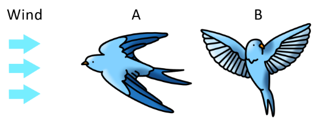
Answer:
The correct answer is (A).
Explanation:
The bird in picture A flies with her wings backward, minimizing the contact surface with the wind and creating less resistance. The bird in picture B flies with her wings in the wind direction, creating much more resistance. The same phenomenon makes a crumpled piece of paper fall faster than an open sheet of paper, which has more surface and more resistance.
Remember the physical principle: The larger the surface of contact with air/wind, the more resistance (force) is created.
Sample Question 2
2. In which direction should the acrobat move his body to balance the seesaw?
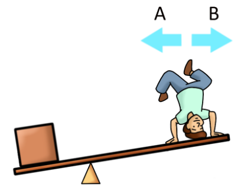
Answer:
A seesaw is an example of a first-class lever, where the fulcrum is between the effort and load. For the seesaw to be balanced, the torque applied by the acrobat must increase. Since the acrobat's weight is constant, the only way to increase the input torque is by increasing the distance from the fulcrum.
Moving in direction B will shift the acrobat’s center of gravity farther from the fulcrum, resulting in greater torque, thereby balancing it.
Force and Moment
A thorough understanding of force and moment (torque) is tested primarily through mechanisms, structures, and levers, in addition to scenarios relevant to the workplace, such as handling hammers and tightening screws.
Sample Question 3
3. Which way is the wagon accelerating?
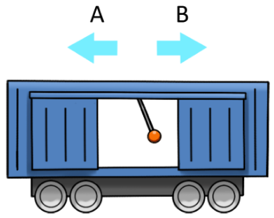
Answer:
The correct answer is A.
Explanation
The pendulum is moving backward; therefore, the car is accelerating in the opposite direction. What happens when an object is in an accelerating system, in the same way, you feel pulled back when the car is speeding up or forwards when it is braking.
Remember the physical principle: When an object is within an accelerating system (another object that accelerates or decelerates), the inner object's force will be in the direction opposite to the acceleration.
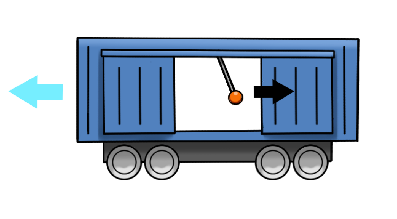
Note: Deceleration is considered a backward acceleration.
Sample Question 4
4. Which pendulum will swing faster?
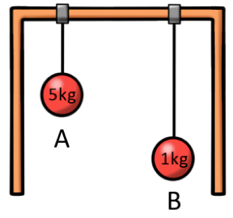
Answer:
The correct answer is A.
Explanation
Pendulum A has a shorter string; therefore, it will swing faster.
Intuitively, the shorter pendulum has less distance to travel in every cycle and, therefore, will move faster.
The bob's mass is irrelevant since the pendulum is affected by gravity, which applies the same acceleration on each body, regardless of its mass. Both bobs accelerate the same; therefore, their mass does not affect the pendulum’s movement.
Remember the physical principle: The only thing that determines how fast a pendulum will swing is its string length.
Looking for additional practice? JobTestPrep provides a comprehensive PrepPack with everything you need to excel on your test including step-by-step explanations and accurate test-like practice questions.
Sample Question 5
5. In which direction does the grey wheel turn?
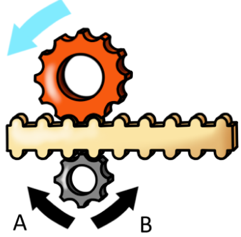
Answer:
The correct answer is A.
Explanation
When contact is made between the rack (toothed belt) and the cogwheels, a conversion from a linear velocity to an angular momentum occurs. The location of the point of contact is critical.
The point of contact between the red cogwheel and the rack is in the lower part of the red cogwheel. The counterclockwise angular velocity induces a linear velocity to the right.
The point of contact between the grey cogwheel and the rack is in the upper part of the grey cogwheel. The linear velocity to the right (determined by the rack) induces an angular momentum in a clockwise direction. The blue arrow shows how each part of the wheel is moving under the rotation conditions:
Remember the physical principle: When converting the linear velocity of a rack to the angular momentum, “translate” the rotation into arrows and follow the directions.
Gears
Even though gears are less common in the Bennett test than other mechanical tests, gear-related questions are sure to appear. The purpose of these questions is to test your knowledge of gear ratios and your ability to determine the direction of rotation of a gear.
Sample Question 6
6. Which granary can hold more wheat?
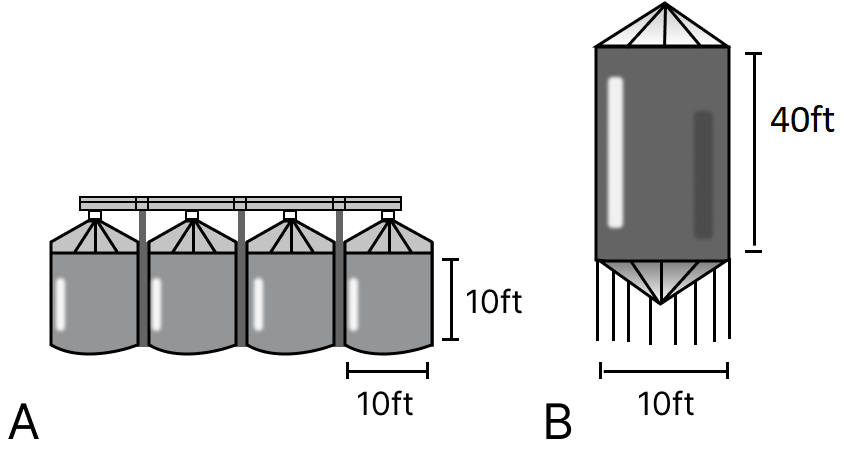
Answer:
The correct answer is C.
Explanation
This question can be solved in a straightforward calculation of the volume of the granaries, using the formula of a cylinder’s volume:
V = π x R2 x H
Π = 3.14, R is the cylinder’s radius, and H is the height of the cylinder.
Calculating:
Answer A: 4 x π x 52 x 10 = 4 x π x 25 x 10 = 3.14 x 100 x 10 = 3,140
Answer B: π x 52 x 40 = π x 25 x 40 = 3.14 x 1,000 = 3,140
However, there is no need for such lengthy calculations. As we can see, the height of the cylinder affects the volume of a cylinder linearly, meaning four cylinders with height H are equal in volume to one cylinder with height 4H:
V (4 short) =4 x {π x R2 x H} = 4 x π x R2 x H
V (1 tall) = π x R2 x 4H = 4 x π x R2 x H
Remember the physical principle: The volume of a cylinder is linearly dependent on its height.
Note: The same does NOT apply to the cylinder’s radius since the R in the formula is squared. In that case, the volume of one cylinder with a radius of 2R will be equal to the volume of four cylinders with a radius R. The volume of one cylinder with a radius of 4R will be similar to the volume of sixteen cylinders with a radius R.
Thermodynamics
It is a big name for a fascinating subject – condensation, evaporation, heating, and cooling. In the future, when you need to cool your beer quickly, you will know how. Don't be afraid to prepare in advance and use Bennett Mechanical Comprehension practice materials to help gain a competitive edge. Other Mechanical Reasoning practice preps include Ramsay and SHL.
Sample Question 7
7. In which direction will the wheel spin?
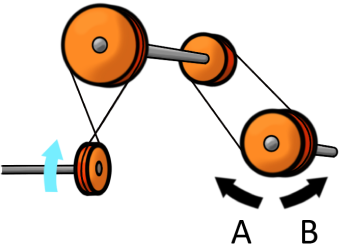
Answer:
The correct answer is B.
Explanation
A band connects the two wheels on the left; therefore, the top's wheel will spin counter-clockwise. The two wheels at the top are connected by a rod; thus, both rotate in the same direction. The wheel in question is connected by a band to the top right wheel and influenced by its rotation.
Sample Question 8
8. Who will need to apply more force to lift the weight? (If equal, Mark C.)
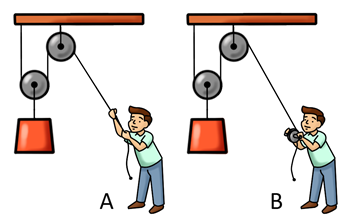
Answer:
The correct answer is C.
Explanation
The figure in B has a wheel to reel in the rope. However, this wheel does nothing to divide the force and only changes the pulling from a linear motion in A to a circular motion in B.
Remember the physical principle: In a pulley system, the wheels that reduce applied force are supporting wheels, not wheels that only change the motion’s direction.
Sample Question 9
9. Which ball will reach the floor first? (If equal, Mark C.)
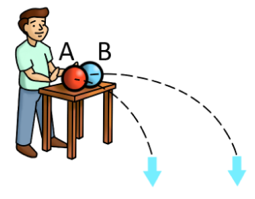
Answer:
The correct answer is C.
Explanation
Gravity is applied onto both balls equally, and the vertical distance they ought to pass is identical. The time needed for both balls to hit the ground is similar, regardless of the horizontal velocity component.
Therefore, it can be deduced that both balls will hit the ground at the same time.
Remember the physical principle: When an object falls under gravity's influence, its vertical velocity does not depend on the horizontal velocity
Sample Question 10
10. Which of the three following diagrams is correct?
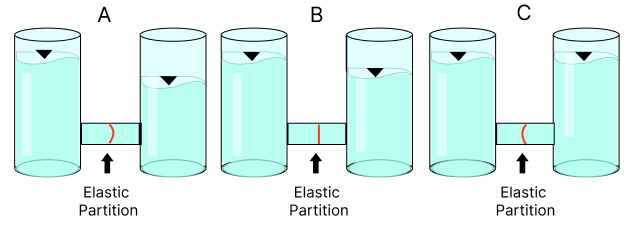
Answer:
The correct answer is A.
Explanation
The bending of the partition is caused by pressure difference on both its sides. The level of water determines the pressure difference in each container.
The height of water determines the pressure on the container – the higher the water – the greater the pressure.
In A, the partition bends to the right, suggesting the pressure is greater on the left side. That is consistent with the higher water level on the left side.
In B, the partition is flat, suggesting no pressure difference between its two sides, despite the different water levels. Therefore, this answer is false.
In C, the partition bends to the left, suggesting the pressure is greater on the right side. That contradicts the higher water level on the left side. Therefore, this answer is also false.
Remember the physical principle: Higher water level – higher pressure.
Fluid Mechanics
In this section, you'll learn about the main concepts of fluid, such as the ideal gas law, basic hydraulics, Bernoulli's principle, and so on. Access the preparation to practice more Fluid Mechanic exercises. Other Mechanical Reasoning practice preps include Ramsay and SHL.
Answer Index
| 1 | 2 | 3 | 4 | 5 |
| A | B | A | A | A |
| 6 | 7 | 8 | 9 | 10 |
| C | B | C | C | A |




